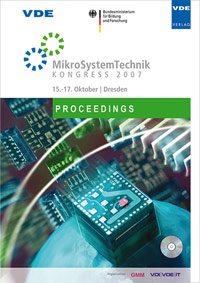Generation of µ - hydrogel spots for cell biology: a new tool for tissue engineering and stem cell culture
Conference: MikroSystemTechnik - KONGRESS 2007
10/15/2007 - 10/17/2007 at Dresden, Germany
Proceedings: MikroSystemTechnik
Pages: 5Language: englishTyp: PDF
Personal VDE Members are entitled to a 10% discount on this title
Authors:
Ehrhart, F.; Gepp, M. M.; Baunach, J. J. S.; Wählisch, F.; Dörr, D.; Zimmermann, H. (Department for cryobiophysics and cryotechnology, Fraunhofer institute for biomedical engineering, Ensheimer Str. 48, 66386 St. Ingbert, Germany)
Howitz, S. (GeSim, Rossendorfer Technologiezentrum, Bautzner Landstraße 45, 01454 Großerkmannsdorf, Germany)
Stark, R. W. (CeNS and Section Crystallography, Department of Earth and Environment, Ludwig-Maximilians-Universität München, Theresienstraße 41, 80333 Munich, Germany)
Abstract:
Selectively encapsulating cells or cell groups (e.g. adult and embryonic stem cells) with μ-hydrogel spots, e.g. alginate, creates a thin layer and protects them from contact with hormones, cell-cell contact or lysis. In other words, a specially arranged co-culture of cells can be established in a single culture dish. This layer is a biocompatible, selectively permeable hydrogel and small molecules like O2, CO2, nutrients and some small hormones (insulin) can pass, whereas large molecules (some larger protein hormones or differentiation factors and humoral and cellular components of the immune system) cannot. In this work a novel method of hydrogel spotting is demonstrated, to achieve 2D encapsulation of adherent cells with a robotic, piezoelectric plotting system. Cells were grown on dishes that were specially treated to promote cell as well as alginate adhesion. UHV-CG alginate solution (ultra-high viscosity, clinical grade alginate), was added, for first trials, manually or by a specially modified nanoplotter. This nanoplotter is designed for sterile application of very small amounts (nanolitres) of highly viscous, aqueous liquids and has a microscopic camera for selecting single cells or cell colonies. After application, alginate was polymerized with barium and stained with alcian blue for better observation. The cells remained vital for at least 7 days. Adjusting the nanoplotter’s parameters (voltage, frequency, pulse width, pressure), allows droplet sizes from some nanolitres until up to several millilitres. Further investigation will focus on technical development and cell differentiation creating several medically interesting co-cultures.


